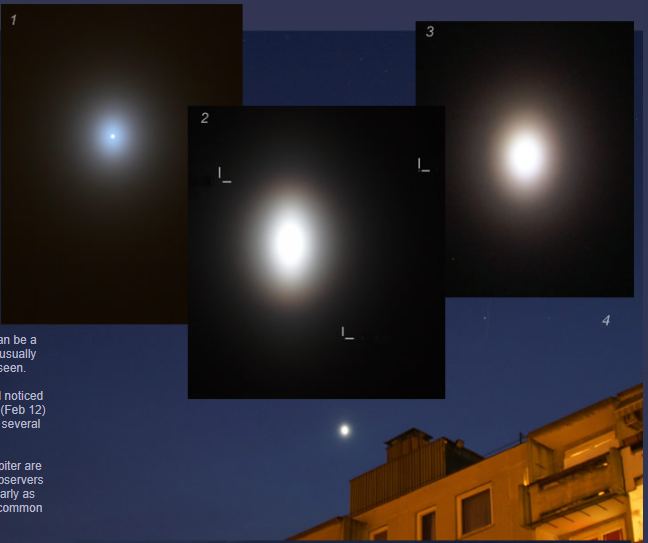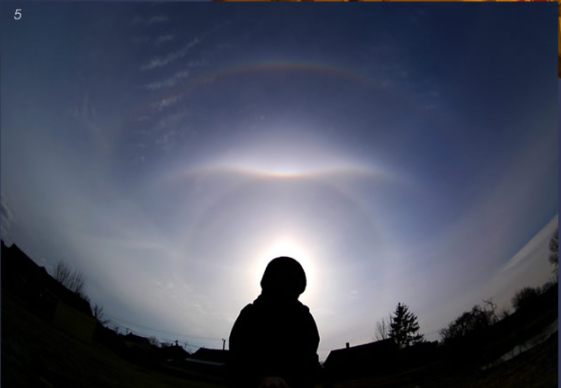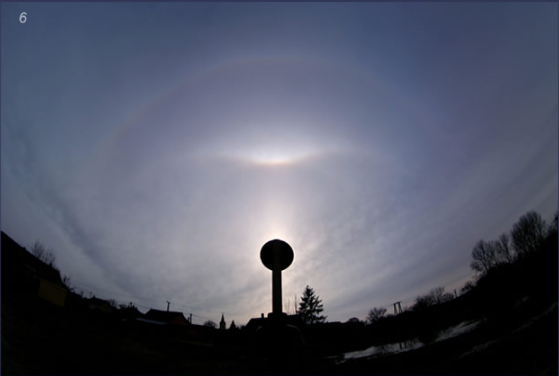Oval Venus Corona?
The Mystery of Oval Venus Coronae
Have you ever looked up at the sky and noticed a beautiful circular corona around the moon or the sun? These optical phenomena are fairly common and occur when tiny droplets in clouds diffract light, creating circular coronae. However, there is another type of corona that is much rarer and more enigmatic - the oval Venus corona. In this article, we will delve into the fascinating world of oval Venus coronae and explore the scientific explanations behind these peculiar atmospheric optics phenomena.
Unveiling the Oval Venus Corona
The oval Venus corona is a captivating sight that has puzzled skywatchers for many years. While coronae around the moon and sun are frequently observed, Venus rarely appears bright enough to produce such coronae. Typically, only the smudge of the central aureole is visible. However, on January 22, 2009, astrophotographer Doug Zubenel captured an image of a vertically elongated oval Venus corona in Kansas. This discovery sparked further interest in this rare atmospheric phenomenon.
A Little-Known Phenomenon
Although oval aureoles around Venus and even Jupiter have been reported by Finnish observers as early as 2001, they remain relatively unknown to the general public. These observations, along with subsequent sightings in Hungary, suggest that oval Venus coronae may be more common than previously thought. However, their infrequent occurrence and lack of widespread awareness have contributed to their mysterious nature.
Exploring the Science behind Oval Venus Coronae
To understand the mechanisms responsible for oval Venus coronae, we must first examine the nature of coronae formation. Most coronae are created when tiny droplets in clouds diffract light, resulting in circular coronae. However, non-circular coronae require oriented non-spherical objects. While pollen grains can generate non-circular solar and lunar coronae as they drift in the wind, the absence of dense pollen clouds during the winter months in Kansas and Hungary eliminates this as a possible explanation.
Ice Crystals as the Key
The key to unraveling the mystery of oval Venus coronae lies in the observation of ice halos in Hungary. These ice halos, captured by astrophotographer Erno Berko, exhibited intense upper tangent arcs and supralateral arcs. These atmospheric phenomena were produced by column-shaped ice crystals with their long axes nearly horizontal. This discovery led researchers to consider whether these column crystals could also be responsible for the formation of oval Venus coronae.
Ice Crystal Clouds and Venus Coronae
Further investigations by Monika Landy-Gyebnar revealed that the clouds present during her corona image were cirrostratus, possibly with a small amount of very thin altostratus. These cloud types consist of ice crystals, suggesting a connection between ice crystal clouds and oval Venus coronae. While most coronae are formed by ice crystal cirrus, the crystals are usually too small and near-spherical in shape to orient themselves through aerodynamic drag forces. However, the size of the objects responsible for oval Venus coronae seems to be larger, ranging from 0.175 to 0.350 mm.
The Role of Orientation
Calculations using IRIS software indicate that coronae with the observed angular size require particles with dimensions of approximately 0.175 to 0.350 mm. These dimensions are significant enough for the particles to be oriented by aerodynamic drag forces and capable of producing halos. When horizontally oriented column crystals or plate crystals are present, they can generate vertically elongated coronae. The degree of elongation depends on the altitude of Venus, as well as the specific characteristics of the ice crystals.
The Unique Nature of Venus
Why do we observe these effects specifically with Venus? The answer lies in its nature as an effectively point light source compared to the larger disks of the sun and moon. This distinction allows for the unique optical phenomena associated with Venus, including the oval coronae that have captured the attention of skywatchers and researchers alike.
In conclusion, oval Venus coronae remain a captivating and elusive atmospheric optics phenomenon. While circular coronae are relatively common, their oval counterparts are much rarer and less understood. Through the observation of ice halos and the study of ice crystal clouds, scientists have begun to unravel the mysteries surrounding these enigmatic coronae. As we continue to explore and learn more about our atmosphere, we can expect to gain further insights into the intriguing world of atmospheric optics and the wonders it holds.

Oval Coronae around Venus (Esthajnalcsillag)
-
Kansas Jan 22, '09 Doug Zubenel (TWAN)
-
Veszprem, Hungary Feb 12, '09 Tamás Ladanyi (site, TWAN)
3-4) Monika Landy-Gyebnar also at
Veszprem, Feb 12.
And Hungarian Halos (5-6) imaged at Ludanyhalaszi Feb 12 by Erno Berk�


Coronae around the moon and sun are fairly commonplace. More rarely, Venus can be a bright enough luminary to make them but usually only the smudge of the central aureole is seen.
Doug Zubenel imaged one in January and noticed that it was vertically elongated. Yesterday (Feb 12) more oval Venus coronas were seen over several places in Hungary.
Oval aureoles around Venus and even Jupiter are not new. They were reported by Finnish observers including Matti Lamminen and others as early as 2001 but although they may be relatively common they are little known.
What is going on? We can discount effects from the phase of Venus - That does not produce them.
Most coronae are made when tiny droplets in clouds diffract the light. Small droplets are always tightly spherical and give circular coronae. To produce non-circular coronae we need oriented non-spherical objects. Non circular solar and lunar coronae are known - pollen grains make them as they drift, oriented by their air sac, in the wind. But mid-winter Kansas and Hungary do not have dense pollen clouds!
The clue was provided by the ice halo images sent by Erno Berko showing an intense upper tangent arc and above it a supralateral arc over Hungary. These halos were seen elsewhere in Hungary and were produced by column shaped ice crystals oriented in the air with their long axes nearly horizontal.
Could the column crystals have also made the Venus coronae?
Monika Landy-Gyebnar confirmed that the clouds at the time of her corona image were "cirrostratus with maybe maybe a small amount of very thin altostratus too". Ice crystal clouds. Some coronae are made by ice crystal cirrus but the the crystals are generally too small (10- 20 micron particles) and near spherical in shape to orient themselves by arodynamic drag forces.
What size objects made the coronae here? Tam�s Ladanyi's image showed stars and he measured their angular separation. This gave the dimensions of his corona as 0.4�x0.3�. Measurements on the other uncropped images combined with lens data in their EXIF files gave (not quite as reliably) Doug's corona as 0.44� vertically and Monika's also 0.44�.
Calculations with IRIS indicate that coronae of this (small) angular size need particles with a dimension of about 0.175 to 0.350 mm depending on whether the outermost extent of the oval is the edge of the aureole or the first ring. That's large enough to be oriented by aerodynamic drag forces and large enough to make halos. Horizontally oriented crystals will make a vertically elongated corona.
It's therefore likely that these Venus coronae were made by horizontal columns. Plate crystals could also give rise to vertically elongated coronae. The elongation of both would depend on the altitude of Venus.
Venus shows these effects because it is effectively a point light source compared with the large disks of the sun and moon.
Images © the individual photographers.
Note: this article has been automatically converted from the old site and may not appear as intended. You can find the original article here.
Reference Atmospheric Optics
If you use any of the definitions, information, or data presented on Atmospheric Optics, please copy the link or reference below to properly credit us as the reference source. Thank you!
-
<a href="https://atoptics.co.uk/blog/oval-venus-corona/">Oval Venus Corona?</a>
-
"Oval Venus Corona?". Atmospheric Optics. Accessed on April 29, 2024. https://atoptics.co.uk/blog/oval-venus-corona/.
-
"Oval Venus Corona?". Atmospheric Optics, https://atoptics.co.uk/blog/oval-venus-corona/. Accessed 29 April, 2024
-
Oval Venus Corona?. Atmospheric Optics. Retrieved from https://atoptics.co.uk/blog/oval-venus-corona/.